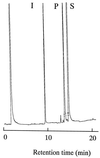Regiospecific internal desaturation of aliphatic compounds by a mutant Rhodococcus strain
- PMID: 10584034
- PMCID: PMC91774
- DOI: 10.1128/AEM.65.12.5636-5638.1999
Regiospecific internal desaturation of aliphatic compounds by a mutant Rhodococcus strain
Abstract
A mutant Rhodococcus strain lacking the ability to utilize 1-chlorohexadecane was found to cis-desaturate aliphatic compounds, such as 1-chlorohexadecane, n-hexadecane, and heptadecanonitrile, yielding corresponding products with a double bond mainly at the ninth carbon from the terminal methyl groups. A new oxidative pathway involving the cis-desaturation step was suggested for alkane utilization by Rhodococcus spp.
Figures


References
-
- Blasig R, Schunck W-H, Jockisch W, Franke P, Muller H-G. Degradation of long chain n-alkanes by the yeast Lodderomyces elongisporus. Appl Microbiol Biotechnol. 1984;19:241–246.
-
- Briglia M, Rainey F A, Stackebrandt E, Schraa G, Salkinoja-Salonen M S. Rhodococcus percolatus sp. nov., a bacterium degrading 2,4,6-trichlorophenol. Int J Syst Bacteriol. 1996;46:23–30. - PubMed
-
- Collins M D. A note on the separation of natural mixtures of bacterial menaquinones using reverse-phase high-performance liquid chromatography. J Appl Bacteriol. 1982;52:457–460. - PubMed
Publication types
MeSH terms
Substances
Associated data
- Actions
LinkOut - more resources
Full Text Sources
Other Literature Sources
Molecular Biology Databases
Miscellaneous

